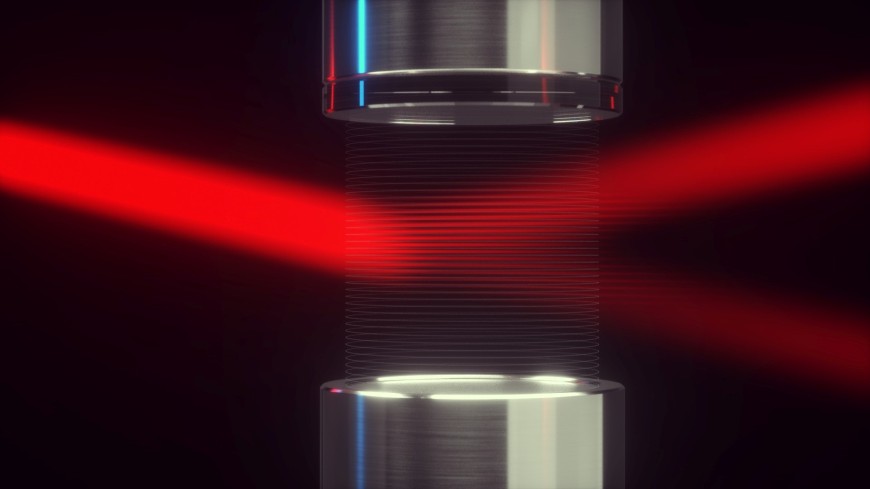Lasers deflected using ultrasound
Potential to revolutionise high performance optics
2023/10/24 by TU Darmstadt und DESY
Using a novel method, beams of laser light can be deflected using air alone. An invisible grating made only of air is not only immune to damage from the laser light, but it also preserves the original quality of the beam, reports the interdisciplinary research team in the journal Nature Photonics.

A collaboration between the Measurement and Sensor Technology Group at etit, Deutsches Elektronen-Synchrotron (DESY), Aalen University of Applied Sciences, the University of Hamburg, Inoson GmbH in St. Ingbert, and the Helmholtz Institute Jena has led to a remarkable advancement in the field of optical manipulation: The innovative technique employs sound waves to modulate the air in the region traversed by the laser beam.
'We have generated an optical grating with the assistance of acoustic density waves,' explains first author Yannick Schrödel, a Ph.D. student at DESY and the Helmholtz Institute Jena. Using powerful ultrasonic transducers, the researchers imprint a pattern of denser and less dense areas in the air, forming a striped grating. Similar to how differential air densities bend light in the Earth's atmosphere, the density pattern assumes the role of an optical grating that alters the direction of the laser light beam. 'However, deflecting light by diffraction grating allows for much more precise control of the laser light compared to deflection in the Earth's atmosphere,' emphasizes Schrödel. 'The properties of the optical grating are influenced by the frequency and intensity – in other words, the volume – of the sound waves.'
High sound pressure level decisive
'Due to successful interdisciplinary research, we were able to demonstrate acousto-optic modulation in air during our first measurement campaign in the DESY laser laboratory,' explains Claas Hartmann, a researcher in the Measurement and Sensor Technology Group. 'The biggest challenge on the acoustic side was achieving a high sound pressure level of 140 decibels at a frequency of 500 kilohertz in air. The acoustic transducer developed in cooperation with Inoson GmbH and our control electronics are capable of generating the required acoustic field. Further optimizations of the components and setup enable us to deflect lasers with peak powers of 20 gigawatts in air, which was previously unattainable.'
This technology has the potential to revolutionize high-performance optics. In laboratory tests, a strong infrared laser pulse could already be redirected with an efficiency of 50 percent. The researchers are working to achieve even higher efficiencies. This breakthrough is particularly significant since lasers of this power class are used in areas such as material processing, fusion research, or cutting-edge particle accelerators, where conventional optical elements are susceptible to damage and degrade the beam quality.
Also transferable to other optical elements
The scientists emphasize that the acoustic control of laser light in gases is not limited to creating optical gratings; it is expected to be transferable to other optical elements such as lenses and waveguides. The collaboration with the Laboratory of Measurement and Sensor Technology at the Department Electrical Engineering an Information Technology at the Technische Universität Darmstadt, including Claas Hartmann, Mathias Rutsch, Sven Suppelt, Jan Helge Dörsam, and Prof. Dr. mont. Mario Kupnik, along with support from Inoson GmbH, played a crucial role in developing this technology.
'We have contemplated this method for a long time and quickly realized that extreme sound levels are necessary. At first, these seemed technically unfeasible,' explains Heyl. 'However, we persevered and ultimately found a solution with the support of researchers from the Laboratory of Measurement and Sensor Technology, as well as Inoson GmbH. Initially, we tested our technique with ordinary air. Next, we will explore other gases to access different wavelengths, optical properties, and geometries.'
Fast switch for high-power lasers
The demonstrated ability to deflect light directly into ambient air opens promising applications, especially as a rapid switch for high-power lasers. 'The potential of contactless control of light and its expansion into other applications can currently only be imagined,' says Heyl. 'Modern optics is almost entirely based on the interaction of light with solid matter. Our approach paves the way in a completely new direction.'
The innovative technology is being developed as part of the research project SOPHIMA – Sono-Photonics in Metafluids. The research project is funded by the Carl Zeiss Foundation.
Reference
Acousto-optic modulation of gigawatt-scale laser pulses in ambient air; Yannick Schrödel, Claas Hartmann, Tino Lang, Jiaan Zheng, Max Steudel, Matthias Rutsch, Sarper H. Salman, Martin Kellert, Mikhail Pergament, Thomas Hahn-Jose, Sven Suppelt, Jan Helge Dörsam, Anne Harth, Wim P. Leemans, Franz X. Kärtner, Ingmar Hartl, Mario Kupnik, Christoph M. Heyl; „Nature Photonics“, 2023; DOI
Illustration of the deflection of lasers by ultrasound
Video: DESY, Science Communication Lab



